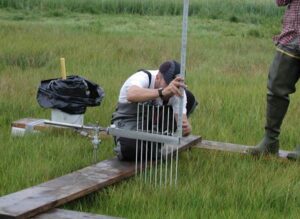
Scientists want their research to be helpful to managers and policymakers. However, this wish does not always translate to reality.
NCCOS scientists are working to change that by involving managers in the research process to ensure the science transitions to useful products for the natural resource management community. Here are some examples of NCCOS research activities that incorporate management, presented by NCCOS staff at the 2018 Ocean Sciences Meeting in Portland, Oregon, last month.
Influence of Shoreline Changes on Chesapeake and Delmarva Bay Ecosystems
This project examines the combined effects of shoreline hardening, watershed land use, water clarity, and Phragmites (marsh reed) invasion of tidal wetlands on habitat quality for submerged aquatic vegetation and estuarine fauna. Project scientists are working with several management agencies from Delaware, Maryland, and Virginia over the course of the project to develop predictive models and other tools that these agencies can use to set shoreline policies and target protection and restoration efforts.
The Ecological Effects of Sea Level Rise Program
This program provides coastal managers and communities with the planning tools needed to make informed decisions about sea level rise and coastal flooding. Projects funded by the program use a collaborative science model, integrating stakeholder input to ensure relevancy and value to coastal managers.

Invasive Species in the Great Lakes
This project is combining scientific, economic, and risk analyses, along with management expertise, to increase forecasting capabilities for the ecological and economic impacts of current and future non-native aquatic species invasions. The goal is to empower natural resource managers to cost effectively respond to current invasions and to prevent future invasions.
These three research activities have common elements that are contributing to their success with management:
- Initial request for proposal (RFA) is grounded in management needs.
- Required management advisory group is specifically stated in the RFA.
- Review process with management input, as a review criterion and on the review panel.
- Carefully chosen advisory team members at the appropriate agency level.
- Routine interaction between management advisors and the science team.
- Flexibility and capacity to adapt to changing needs, personnel, and budget constraints.
- NOAA program manager, or the project’s principal investigator, actively engages management
representatives throughout the life of the project.
Invasive mussels and Eurasian ruffe. Credit: D. Beletsky, University of Michigan.
